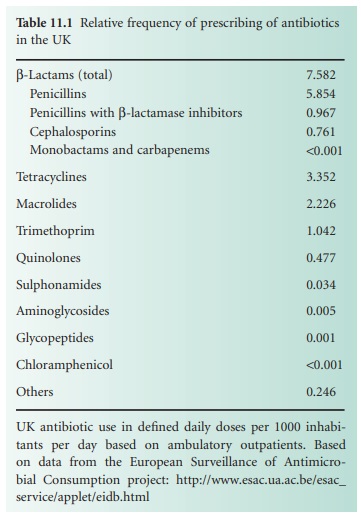Antibiotic Usage
| Home | | Pharmaceutical Microbiology | | Pharmaceutical Microbiology |Chapter: Pharmaceutical Microbiology : Antibiotics And Synthetic Antimicrobial Agents: Their Properties And Uses
Despite the fact that few new classes of antibiotics have been developed in recent years, there are, nevertheless, a large number of different antibiotics in current use.
ANTIBIOTIC USAGE
Despite the fact that few new classes of antibiotics have been developed
in recent years, there are, nevertheless, a large number of different
antibiotics in current use. Some of these are only available in particular
countries; and even within a single country the list of available antibiotics
changes year by year as new products replace old ones that are withdrawn for
commercial reasons or as a result of toxicity concerns. Currently in the UK
there are approximately 70 antibacterial antibiotics, 20 antifungals and 40
antiviral agents on the market, and numbers are similar in other countries, so
it is not the intention in this chapter to describe, or necessarily even to
mention, all of these drugs. Instead, the approach will be to consider the
important constituents of the major antibiotic classes and refer the reader to
more detailed sources for information about some of the less frequently used
agents.
The various classes of antibacterial antibiotics will be considered in
their order of importance in terms of usage, which will be taken to mean the frequency
with which they are prescribed. Surprisingly perhaps, this does not necessarily
coincide with their rank order in terms of the amount manufactured by the
pharmaceutical industry each year, because a significant fraction of the annual
production is used in animal feed supplements. According to one estimate, the
amount used in this way in the USA has been as much as eight times that used to
treat human infections.
Table 11.1 shows the relative frequency of prescribing of the major antibiotic classes as determined by recent data from an ongoing Europewide survey of hospital outpatient prescriptions. The relative numbers would be likely to change somewhat if the survey were to be conducted on inpatient prescriptions or on those issued by community medical practitioners, but some general trends are clear. β-Lactam antibiotics are, by far, the most frequently prescribed class, and of these, prescriptions for penicillins substantially outnumber those for cephalosporins. Trimethoprim features strongly, and as an individual drug would rank very highly even in comparison to penicillins given that the value of 5.854 represents total prescriptions for nearly 10 different penicillins (see section 2 below). Antibiotics that are available primarily as parenteral products, e.g. aminoglycosides and glycopeptides, are much less likely to be prescribed for outpatients than for inpatients because of the problems of administration, so they appear low in the rank order on this particular survey. It is worth emphasizing that this is part of a European survey, and the popularity of particular antibiotics and, consequently, the rank order of the table, is likely to vary from one country to another.

Related Topics
